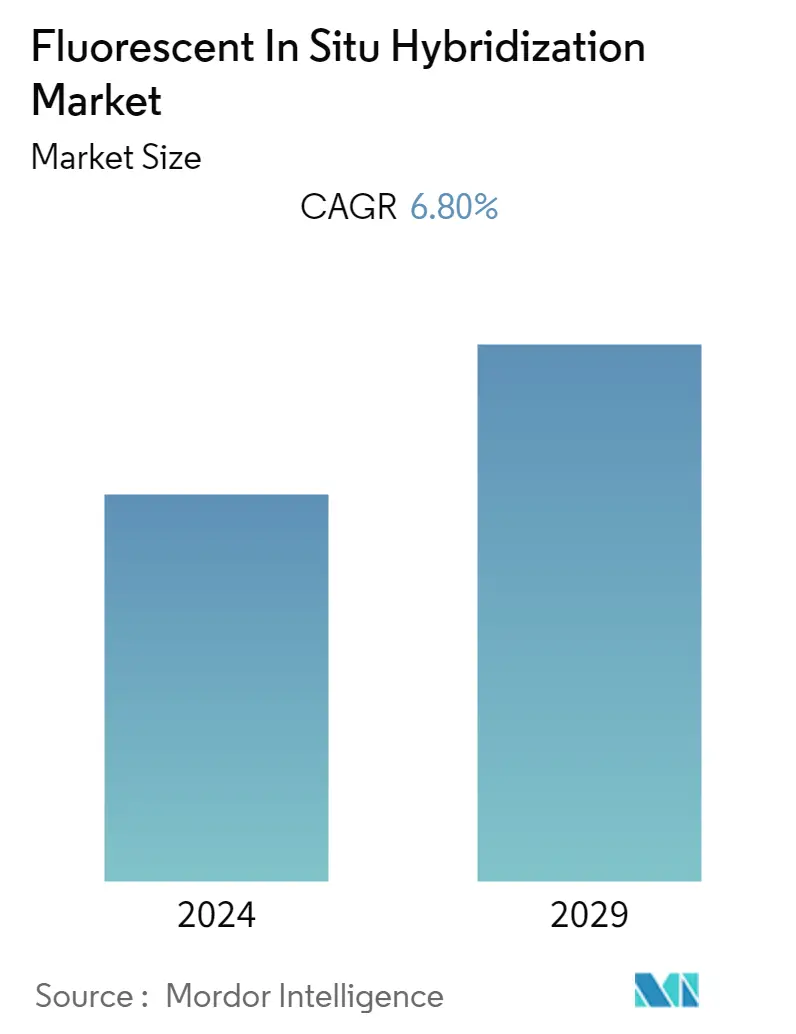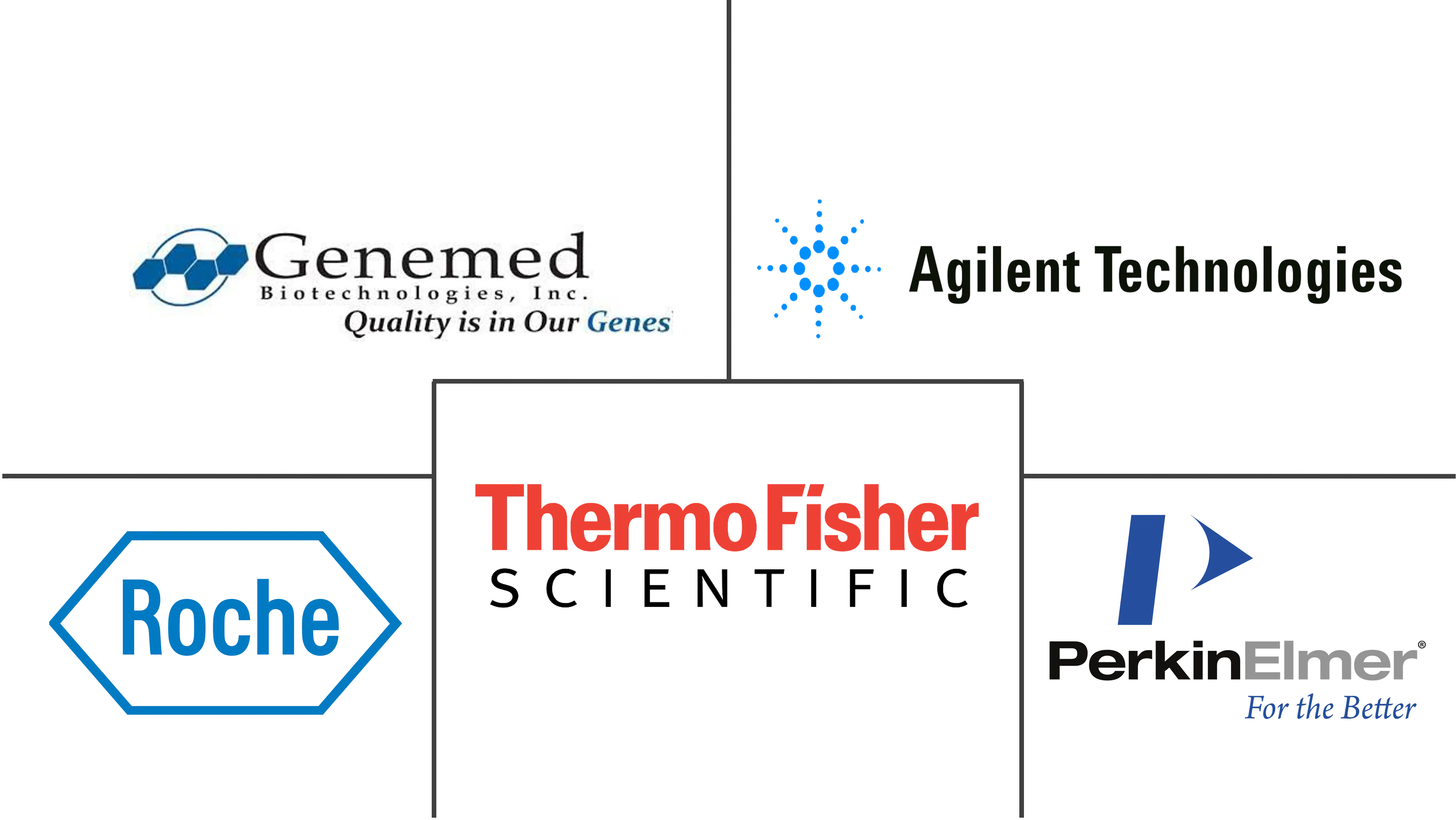Market Size of Fluorescent In Situ Hybridization Industry

| Study Period | 2019 - 2029 |
| Base Year For Estimation | 2023 |
| Forecast Data Period | 2024 - 2029 |
| CAGR | 6.80 % |
| Fastest Growing Market | Asia Pacific |
| Largest Market | North America |
Major Players
*Disclaimer: Major Players sorted in no particular order |
Fluorescent in Situ Hybridization Market Analysis
The Fluorescent In Situ Hybridization Market is poised to grow at a CAGR of 6.8% over the forecast period.
COVID-19 profoundly impacted the studied market owing to the rising research studies deploying fluorescence in situ hybridization. For instance, in an article published in the PLOS One Journal in November 2022, fluorescence in situ hybridization (FISH)-based evaluation method was used for the detection of SARS-CoV-2 in saliva. All saliva samples were FISHed with a Cy3-labeled SARS-CoV-2-specific DNA probe and were analyzed manually by fluorescence microscopy (proof-of-concept). However, the market is expected to show a stable growth rate during the forecast period owing to the rising prevalence of cancer and genetic diseases globally.
In addition, the growing burden of cancer and genetic diseases and innovation in FISH products are actively affecting the growth of the studied market.
According to the Canadian Cancer Society May 2022 update, it was estimated that 30 thousand Canadians would be diagnosed with lung and bronchus cancer, representing 13% of all new cancer cases in 2022. As fluorescent in situ hybridization is used to diagnose various types of cancer to find chromosomal abnormalities, there is an increasing demand for FISH, thereby driving the market.
Furthermore, fluorescence in situ hybridization (FISH) is used to detect and locate a specific DNA sequence on a chromosome. It is also used as a molecular cytogenetic technique to diagnose genetic diseases. For instance, according to the World Alzheimer Report published in September 2021, over 55 million people live with dementia worldwide. This is forecasted to reach 78 million by 2030. Also, as per the Alzheimer's Association 2021 report, an estimated 6.2 million Americans aged 65 and older were living with Alzheimer's dementia in 2021 in the United States. By 2050, the number of people aged 65 and older with Alzheimer's dementia is projected to increase to 12.7 million. The increasing burden of Alzheimer's disease globally surges the demand for FISH used in the genetic testing of the disease condition, thereby leading to the growth of the studied segment market.
FISH is mainly used for locating specific DNA sequences, diagnosis of genetic diseases, and gene mapping; its use in genomics is vital. The increasing funding and investment by biotechnology and pharmaceutical companies and government organizations for research and innovation in the field of genomics is estimated to propel market growth. For instance, according to the NIH National Human Genome Research Institute (NHGRI) 2022 report, the FY 2022 United States President's Budget request for human genomics research is USD 633.0 million, an increase of USD 17.0 million compared with the previous year. In order to improve human health, NHGRI interacts with a variety of groups, performs and funds genomics research, and educates the next generation of genomics specialists. The huge investment by the NHGRI in the genomics study is expected to utilize a large amount of FISH during the research, which is expected to propel the market growth during the forecast period.
Therefore, owing to the aforementioned factors, such as the high prevalence of cancer and genetic diseases and rising funding leading to the high utility of FISH, the studied market is anticipated to witness growth over the analysis period. However, a lack of awareness about emerging diagnostic technologies in cytogenetics is likely to impede market growth.
Fluorescent in Situ Hybridization Industry Segmentation
As per the scope of the report, Fluorescent In Situ Hybridization (FISH) is mainly used for diagnostic purposes and involves fluorescent probes that bind to a nucleic acid that very well complements it. The Fluorescent In Situ Hybridization Market is segmented by Product Type (Analytical Instrument, Kits & Reagents, and Software & Services), Application (Cancer, Genetic Diseases, and Others), and Geography (North America, Europe, Asia-Pacific, Middle East and Africa, and South America). The market report also covers the estimated market sizes and trends for 17 different countries across major regions globally. The report offers the value (in USD million) for the above segments.
| By Product Type | |
| Analytical Instrument | |
| Kits & Reagents | |
| Software & Services |
| By Application | |
| Cancer | |
| Genetic Diseases | |
| Others |
| Geography | ||||||||
| ||||||||
| ||||||||
| ||||||||
| ||||||||
|
Fluorescent In Situ Hybridization Market Size Summary
The fluorescent in situ hybridization (FISH) market is experiencing a positive trajectory, driven by the increasing prevalence of cancer and genetic diseases, alongside advancements in FISH technology. This molecular cytogenetic technique is pivotal for diagnosing various cancers and genetic disorders by detecting and locating specific DNA sequences on chromosomes. The market's growth is further supported by the rising demand for FISH in research studies, such as those focused on detecting SARS-CoV-2 and genetic testing for conditions like Alzheimer's disease. The substantial investment from biotechnology and pharmaceutical companies, as well as government organizations in genomics research, is expected to enhance the utility of FISH, thereby propelling market expansion over the forecast period.
Regionally, North America is anticipated to dominate the FISH market due to the high burden of chronic diseases and significant spending on cancer genomics and genetic research. The region's focus on gene engineering projects and the approval of new FISH-related products are key factors contributing to its market leadership. The competitive landscape of the FISH market is moderately fragmented, with several global and regional players holding substantial market shares. Companies such as ThermoFisher Scientific Inc., Agilent Technologies, and Merck KGaA are prominent in the market, actively engaging in research and product development to maintain their competitive edge. Despite the promising growth prospects, the market faces challenges, including a lack of awareness about emerging diagnostic technologies in cytogenetics, which could potentially hinder its expansion.
Fluorescent In Situ Hybridization Market Size - Table of Contents
-
1. MARKET DYNAMICS
-
1.1 Market Overview
-
1.2 Market Drivers
-
1.2.1 Growing Burden of Cancer and Genetic Diseases
-
1.2.2 Advancements in Products
-
-
1.3 Market Restraints
-
1.3.1 Lack of Awareness about Emerging Diagnostic Technologies in Cytogenetics
-
-
1.4 Porter Five Forces
-
1.4.1 Threat of New Entrants
-
1.4.2 Bargaining Power of Buyers/Consumers
-
1.4.3 Bargaining Power of Suppliers
-
1.4.4 Threat of Substitute Products
-
1.4.5 Intensity of Competitive Rivalry
-
-
-
2. MARKET SEGMENTATION
-
2.1 By Product Type
-
2.1.1 Analytical Instrument
-
2.1.2 Kits & Reagents
-
2.1.3 Software & Services
-
-
2.2 By Application
-
2.2.1 Cancer
-
2.2.2 Genetic Diseases
-
2.2.3 Others
-
-
2.3 Geography
-
2.3.1 North America
-
2.3.1.1 United States
-
2.3.1.2 Canada
-
2.3.1.3 Mexico
-
-
2.3.2 Europe
-
2.3.2.1 Germany
-
2.3.2.2 United Kingdom
-
2.3.2.3 France
-
2.3.2.4 Italy
-
2.3.2.5 Spain
-
2.3.2.6 Rest of Europe
-
-
2.3.3 Asia-Pacific
-
2.3.3.1 China
-
2.3.3.2 Japan
-
2.3.3.3 India
-
2.3.3.4 Australia
-
2.3.3.5 South Korea
-
2.3.3.6 Rest of Asia-Pacific
-
-
2.3.4 Middle-East and Africa
-
2.3.4.1 GCC
-
2.3.4.2 South Africa
-
2.3.4.3 Rest of Middle-East and Africa
-
-
2.3.5 South America
-
2.3.5.1 Brazil
-
2.3.5.2 Argentina
-
2.3.5.3 Rest of South America
-
-
-
Fluorescent In Situ Hybridization Market Size FAQs
What is the current Fluorescent In Situ Hybridization Market size?
The Fluorescent In Situ Hybridization Market is projected to register a CAGR of 6.80% during the forecast period (2024-2029)
Who are the key players in Fluorescent In Situ Hybridization Market?
ThermoFisher Scientific Inc. , Agilent Technologies , Genemed Technologies Inc. , PERKINELMER Inc. and F. HOFFMANN-LA ROCHE LTD. are the major companies operating in the Fluorescent In Situ Hybridization Market.

